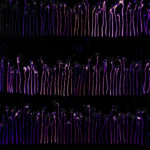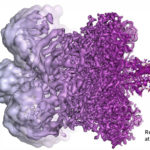A plant’s health and development is influenced by the complex community of microbes that surrounds it. Researchers at the Joint Genome Institute (JGI) and their collaborators at the Howard Hughes Medical Institute at the University of North Carolina have identified some 350 genes of the bacterium Pseudomonas simiae that positively or negatively impact how effectively this beneficial microbe colonizes plant roots. Cataloging these genes—and understanding the cellular functions that they’re involved in—is the first step toward developing targeted approaches to improving plant health and growth for a number of applications. The results of the study were published in PLOS Biology. Read more on the JGI website..
Biosciences Researchers Helped Lay Foundation for Nobel-Winning Cryo-EM
Several Berkeley Lab researchers contributed to the foundational work leading to the development of cryo-electron microscopy (cryo-EM), for which Jacques Dubochet, Joachim Frank, and Richard Henderson were awarded the 2017 Nobel Prize in Chemistry. Among those cited in the Scientific Background are Biosciences’ Bob Glaeser, Ken Downing, and Eva Nogales.
New Addition to Family of Light-responsive Proteins
A study led by Cheryl Kerfeld, with colleagues from Biosciences’ Molecular Biophysics and Integrated Bioimaging (MBIB) Division, as well as her MSU-DOE Plant Research group at Michigan State University, made the cover of the August 2017 issue of Nature Plants. Matthew Melnicki, Markus Sutter, and Fei Cai of MBIB contributed to the study, which characterized a recently identified member of the orange carotenoid family of proteins (OCPs). These proteins change conformation in response to ambient light conditions to protect the host cyanobacteria from harmful exposure. Compared to the canonical exemplar, OCP1, the new OCP, called OCP2, requires relatively higher light intensity for activation, but it reacts faster than OCP1. The goal of Kerfeld’s OCP research is to understand how the various members of the family work, and use that knowledge to engineer the protein for applications in renewable energy and medicine. Read more from the MSU-DOE Plant Research Lab.
Mina Bissell’s Research Discussed in The New Yorker
Pulitzer Prize-winning author Siddhartha Mukherjee discussed the work of Biosciences’ Mina Bissell in a feature on worldwide research efforts to understand the factors that determine whether cancer will spread. Bissell, a distinguished scientist in the Biological Systems and Engineering (BSE) Division, has shown that a cancer cell’s local tissue environment affects whether or not it will form a metastatic tumor. The article appeared in the Sept. 11 edition of The New Yorker.
Follow the Biosciences Area on LinkedIn
 The Biosciences Area has launched a new LinkedIn page. This platform will support the dissemination of the Area’s news and opportunities to a wider audience. LinkedIn offers exciting features that the Biosciences communications team will be further exploring in the future. To get updates via LinkedIn please make sure to click the “follow” button.
The Biosciences Area has launched a new LinkedIn page. This platform will support the dissemination of the Area’s news and opportunities to a wider audience. LinkedIn offers exciting features that the Biosciences communications team will be further exploring in the future. To get updates via LinkedIn please make sure to click the “follow” button.
You can also stay up to date with the latest news from the Area’s Divisions and User Facility by following the Biosciences Twitter account.
- « Previous Page
- 1
- …
- 140
- 141
- 142
- 143
- 144
- …
- 213
- Next Page »
Was this page useful?








